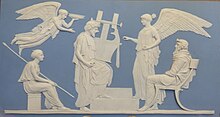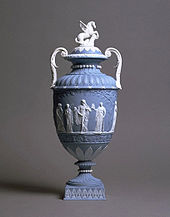Jasperware


Jasperware [ ˈdʒɛspɐwɛː ] (from English, after the mineral jasper ) describes an industrially processed ceramic material, which is technologically incorrectly classified partly as stoneware , partly as soft-paste porcelain . Actually, it can be attributed to the earthenware , since its essential components are clay , barite and flint .
history
Jasperware was developed by Josiah Wedgwood in Staffordshire . Its shapes are inspired by ancient models and mark the change in style to classicism in English ceramics. Wedgwood sought the highest artistic quality through the use of designers such as John Flaxman . Since the end of the 1760s, he had developed basalt ware, a solid black, very hard, stoneware-like material.
Since around 1775 he has been shaping his vessels and decorative items in pastel-colored masses. Masses dyed through with metal oxides were processed into unglazed goods which were given a matt, biscuit-like surface. The colors used were predominantly matt blue, but also sea green, yellow and gray. Often separately modeled reliefs made of white clay were applied to this colored ground (and in fact pressed into shapes in a very similar way to Spekulatius), which were designed to create an outline. The imitations of the Portland vase, which was regarded as antique by Wedgwood using this technique, became famous in 1790 . Based on traditional techniques and shapes, Jasperware is still produced today.
literature
- Wolf Mankowitz: Wedgwood , London 1966
